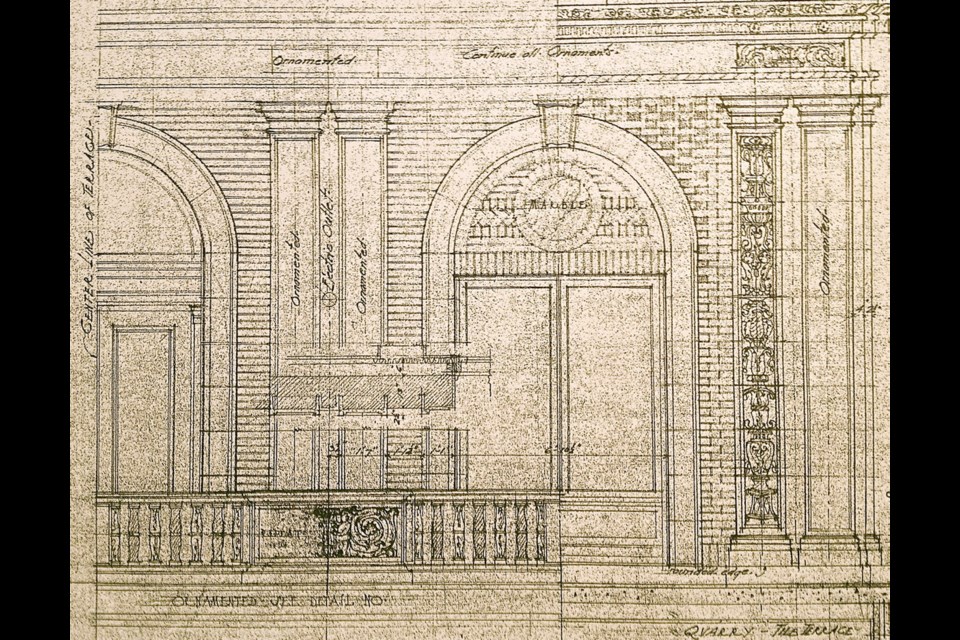The devastating 1906 earthquake in San Francisco left a legacy in Victoria: the Union Club of British Columbia near the Inner Harbour.
Architect Loring P. Rixford, of San Francisco, designed the Italianate building at 805 Gordon St., across from the Empress Hotel.
Rixford was fresh from experience drawn from the rebuilding of San Francisco and put this knowledge into the Union Club building, completed in 1913. And the result has stood solidly against Victoria’s shakes, minor shocks and most of the wear of time ever since.
“This building was built to the best standards that they had developed after that earthquake,” said Barrie Hewstan, past-president of the Union Club. “That’s why it has stayed in relatively good shape all of these years.”
The four-storey building is a monument to the Edwardian high society of Victoria prior to the First World War. Its brick and terra cotta exterior and overall design were completed in what is now called Italian Renaissance Revival Style. The building was recognized as nationally significant in 1995 by the joint federal, provincial and territorial administered registry, Canada’s Historic Places.
Despite its solid structure, however, the outside of the building has started to sag and crack. These problems are mostly the result of age and some water damage to iron work holding the building’s exterior skin. Most significantly, the building’s terra-cotta cornices, sills, railings and decorative implants have cracked here and there.
Terra cotta is a glazed concrete product, fired or kiln-cured. In its day, terra cotta was one of the most durable building exteriors known.
Union Club president Lorne DeLarge said researchers dived into club archives and found the name of the manufacturer of the original terra cotta work, Gladding McBean of California, which is still in business.
DeLarge said the company was contacted and asked if it had any records of the job. In fact, Gladding McBean had stored all the original plans and blueprints and was happy to lend them as part of the restoration.
“So now we’ve got a full copy of the original plans,” he said.
As the work progresses, where chipped or otherwise necessary, the terra cotta will be removed. Its underlying iron work will be replaced with long-lasting galvanized steel.
Then, if possible, the original terra cotta will be re-installed. Where necessary, newly made terra cotta, produced by a company in Buffalo, New York, will be installed.
In all, about 80 terra cotta pieces will have to be replaced.
The total cost of the job will be about $2.2 million and the club plans to have it completed by fall.
The Union Club of British Columbia was founded in 1879. Its first president was Sir Matthew Baillie Begbie, the first Supreme Court judge of British Columbia.
The “Union” in the name refers to the political will in Victoria of the time to unite with Canada and remain part of the British Empire. Another segment of the community wished to be independent, or even join the United States and continue brisk trade with San Francisco.
The Union Club’s first meeting, in April 1879, when Begbie was made president, took place in a space over a butcher shop at the corner of Yates and Government streets.
It later moved to Douglas Street, near St. Andrew’s Presbyterian Church.
The existing building was finally commissioned and opened with a grand ball in August 1913. Total cost, frantically financed with loans, notes and debentures, was to reach $351,000.
Art and architecture historian Martin Segger, a Union Club member who researched the building, said although it was not designed by the famous Francis Rattenbury, Rattenbury’s influence is very much in evidence.
Before the club was built, Rattenbury had earned praise for his designs of the B.C. legislature and later the Empress Hotel and the CPR Steamship Building, now housing the Robert Bateman Centre.
Segger said Rattenbury, a Union Club member himself, helped select Rixford and worked closely with him during the design. So Rattenbury ensured its design and placement were in keeping with his overall vision for the Inner Harbour.
“If you read the original club minutes of the time when Rixford appeared before the club board to give an update, Rattenbury was always at his right hand,” he said.
Segger said while researching the Union Club building he and others were led into the California State Archives. They found correspondence between Rixford and the terra cotta company Gladding McBean.
It was a surprise to learn the original design work included terra cotta rosettes, rose-shaped pieces that are not found on the building. In fact, a series of empty holes sit now under the cornices at the building top where the drawings indicate rosettes.
“It’s a bit of mystery,” said Segger. “Things went missing, deliveries weren’t made and stuff arrived broken.”
So, it has been decided when the restoration work is completed the rosettes, as they were originally envisioned by Rixford, will be installed.
“We will complete it with the rosettes in the cornice,” Segger said.
